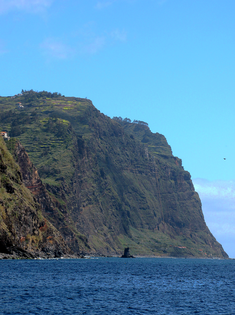Cabo Girão
| Cabo Girão | |
|---|---|
 The cliff face of Cabo Girão as seen straight down from viewpoint | |
| Highest point | |
| Peak | Cabo Girão (Câmara de Lobos) |
| Elevation | 589 m (1,932 ft) |
| Coordinates | 32°39′23″N 17°0′24″W / 32.65639°N 17.00667°WCoordinates: 32°39′23″N 17°0′24″W / 32.65639°N 17.00667°W |
| Naming | |
| Etymology | cabo girão, Portuguese compound phrase for cape of cultivation |
| Geography | |
| Country |
|
| Autonomous Region |
|
| Civil Parish | Câmara de Lobos and Quinta Grande |
| Geology | |
| Orogeny | Volcanism |
| Period | Miocene |
Cabo Girão is a lofty sea cliff located along the southern coast of the island of Madeira, in the Portuguese archipelago of Madeira. Cabo Girão is a popular lookout point, especially after a glass-floored viewing platform was installed in October 2012.[1] The location is a popular starting point for hikers.
Geography


It is situated less than two kilometres west from the centre of Câmara de Lobos, between the parishes of Quinta Grande and Câmara de Lobos. A diamond-shaped sea-cliff escarpment from 560 metres (1,840 ft) to 589 metres (1,932 ft) above sea level, Cabo Girão lies between two river-valleys that flow into the Atlantic Ocean. The escarpment/cliffs extend approximately three kilometres between the urban sprawl of Câmara de Lobos to the east and the river-valley of Quinta Grande in the west.
Although brochures claim that it is the second highest cliff in Europe, at least five European cliffs (Hornelen at 860 metres, Cape Enniberg at 750 metres, Vixía Herbeira at 613 metres, Preikestolen at 604 metres and Slieve League at 601 metres) are higher.
There are terraced fields (Fajãs de Cabo Girão) located below the sheer cliffs, which at one time only accessible by boat. In August 2003, a cable car was installed on the slope of the cliff so farmers can reach these low-lying fields.
Architecture
Apart from the communications towers that are installed on Cabo Girão, the Cape is noted for the Chapel of Nossa Senhora da Fátima (English: Our Lady of Fátima),[2] which was built in 1974 to replace a much smaller chapel built in 1931.